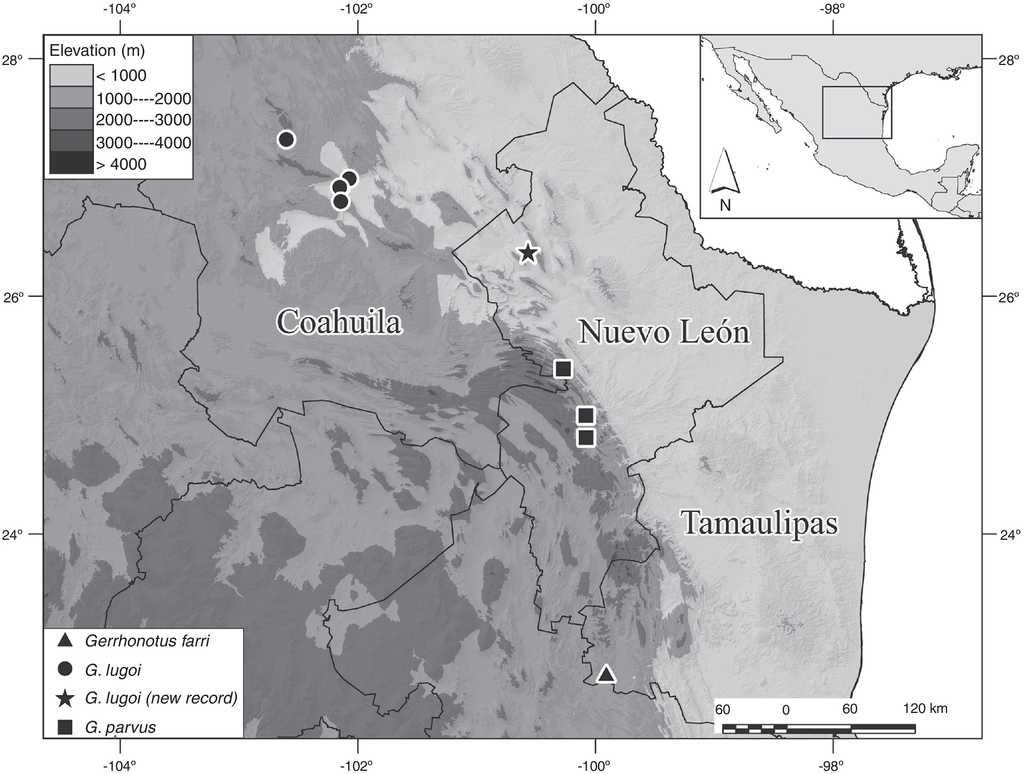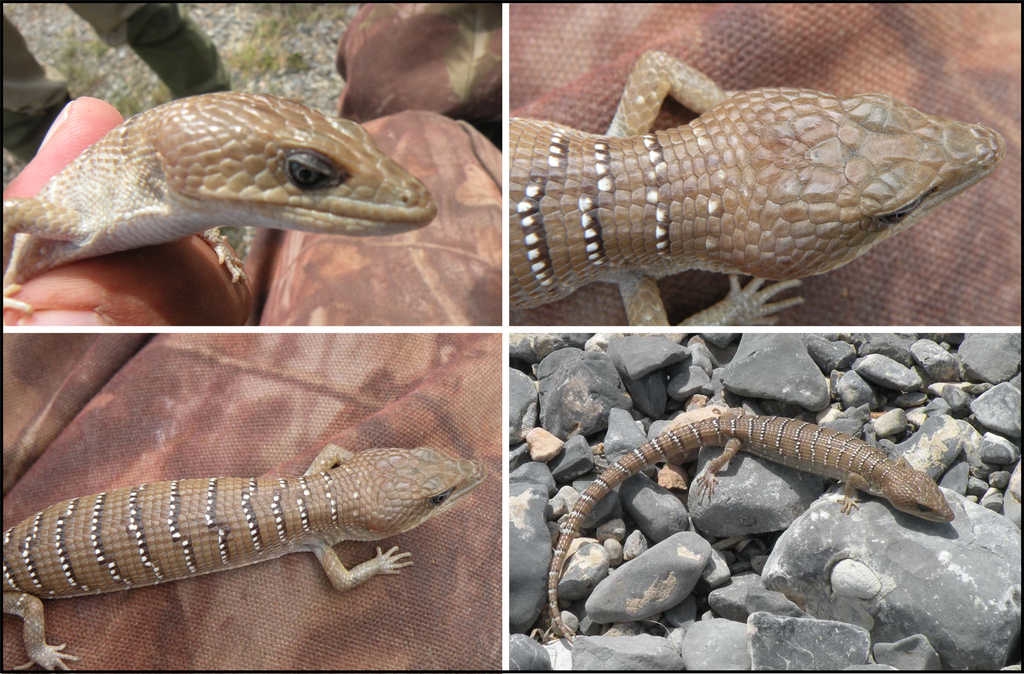The alligator lizard Gerrhonotus lugoi was described on the basis of 2 specimens from the Cuatro Ciénegas Basin, Coahuila, Mexico (McCoy, 1970). Nine additional specimens have been reported since the species description. However, 2 specimens reported by Lazcano, Contreras, and Nevares-de los Reyes (1993) were subsequently lost (Bryson & Graham, 2010). Most specimens were collected in the vicinity of the Sierra San Marcos y Pinos, south of Cuatro Ciénegas (Bryson & Graham, 2010; Lazcano et al., 1993; McCoy, 1970), and 1 specimen was collected 14.2 miles west of Ocampo in the Sierra La Madera, northwest of Cuatro Ciénegas (Bryson & Graham, 2010).
Gerrhonotus lugoi differs from other alligator lizards except G. farri and G. parvus in having smooth dorsal scales. Additionally, G. farri, G. lugoi, and G. parvus lack a postrostral, further differentiating these species from other Gerrhonotus. Gerrhonotus lugoi differs from G. parvus by possessing anterior internasals and by lacking rostral-nasal contact, contact between the supranasals and cantholoreals. Finally, G. lugoi differs from G. farri by having more longitudinal dorsal scale rows (18-19 vs. 14), longitudinal ventral scale rows (14 vs. 12), suboculars (3 vs. 2), and primary temporals (5 vs. 4) (Bryson & Graham, 2010; McCoy, 1970).
On October 7, 2010, at approximately 19:00, GJHE observed an adult male of G. lugoi (Fig. 1) in Rancho El Cuarto, Municipality of Mina, Nuevo León, Mexico (26.3°70′83″ N, 100.5°65′55″ W, WGS 84; 730 m asl). The specimen was found active on the ground. Vegetation in the locality is characterized by the presence of relatively dense, low-growing desert shrubs, such as creosote bush (Larrea tridentata) and mariola (Parthenium incanum), and tall yuccas (Yucca filifera, Y. treculeana), with scattered dense clumps of false agave (Hechtia glomerata) and various cacti (Opuntia spp.) (Villareal, 1988).
Gerrhonotus lugoi is protected by the Mexican government and is considered a threatened species, endemic to the state (NOM-059 SEMARNAT; Semarnat, 2010). Thus, the specimen was released in the same place of the observation after data collection in the lab. Several photographs were deposited in the herpetological collection of the Museo de Zoología, Facultad de Estudios Superiores Zaragoza, Universidad Nacional Autónoma de México (MZFZ IMG 002-13).
Our record is the twelfth known specimen for the species and the first one for the state of Nuevo León and outside of Coahuila, extending the known range ca. 166 km (airline) SE of the closest record in the mountains adjacent to Poza La Becerra, Sierra de San Marcos, Cuatro Ciénegas, Coahuila (Bryson & Graham, 2010; Fig. 2). Additionally, it represents the southernmost record of G. lugoi and the closest to records to G. parvus (Bryson & Graham, 2010; Fig. 2).

Figure 2 Locality records for Gerrhonotus lugoi, G. parvus, and G. farri. The star represents the new locality of G. lugoi. Modified from Bryson and Graham (2010).
The specimen shows most of the diagnostic characters of G. lugoi. Given the scarcity of known specimens for the species, we proceed to describe its scale and color pattern below (nomenclature of scales follows Good [1988,1994]):
Measurements (in millimeters): snout-vent length, 103.4; tail length, 116.3; width of body at its maximum, 21.0; width of tail at base, 11.1; width of head, 19.3.
Scale pattern. Head scales smooth. Snout rounded in dorsal and lateral views; rostral approximately twice as wide as high, in broad contact with anterior internasals; anterior internasals expanded, separating nasals from rostral and contacting each other medially; postrostral absent; frontonasal as wide as long, in contact with prefrontals posteriorly; supranasals elongate, not expanded dorsally; postnasals 2/2, lower postnasal contacting third and fourth supralabials; posterior internasals enlarged, in contact with anterior canthals laterally, and with each other medially. Loreals 2-2; canthals 2-2; preoculars 2-2; superciliaries 5-5, anterior most one in contact with posterior canthal. Suboculars 3-3; postoculars 3-3. Frontonasal broader than long, contacting both anterior and posterior canthals; frontal large, in contact with prefrontals, second and third medial supraoculars, frontoparietals, and parietal. Frontoparietals as wide as long, in lateral contact with third and fourth medial supraoculars. Medial supraoculars 5/5; lateral supraoculars 3/3. Interparietal small, slightly elongate, kite-shaped, enclosed by frontoparietals, parietals, occipitals, and interoccipital; pineal eye poorly defined, situated in posterior half of interparietal. Primary temporals 5-5; secondary temporals 4-4; upper primary temporal in contact with upper secondary temporal, parietals, and frontoparietals. Supralabials 15-15; infralabials 12-12. Dorsal scales smooth, slightly convex, highly polished, in 18 longitudinal and 47 transverse rows from anterior insertion of forelimbs to anus; lateral fold reduced to 2 or 3 rows of granules at midbody.
Color pattern. Head scales uniform light brown. Dorsal color light brown. Twelve light crossbands on dorsum between head and posterior insertion of legs and 16 on tail. Crossbands one scale row-wide, anterior half of each scale dark, posterior half light. Lateral fold light brown. Venter nearly immaculate, pearly white; lateral ends of dorsal crossbands faintly visible on outer ventral scale rows.
Support for field work for additional records of G. lugoi was provided by grants from Conabio (JF065) to A. Nieto, from resources of the WWF-Alianza Carlos Slim (L039), and Conacyt to U. García (CVU 48339). Thanks to Centro de Proyectos Tamaulipas A.C. (CEPROTAM), Universidad Autónoma de Tamaulipas for logistic support. C. J. Pavón-Vázquez provided helpful comments on early drafts of the manuscript, and 2 anonymous reviewers on the final version. Lastly, we thank the Posgrado en Ciencias Biológicas of the Universidad Nacional Autónoma de México for its support. This work is part of the Ph. D. research project of U. García-Vázquez.











 text new page (beta)
text new page (beta)



